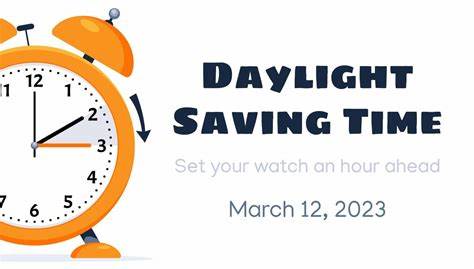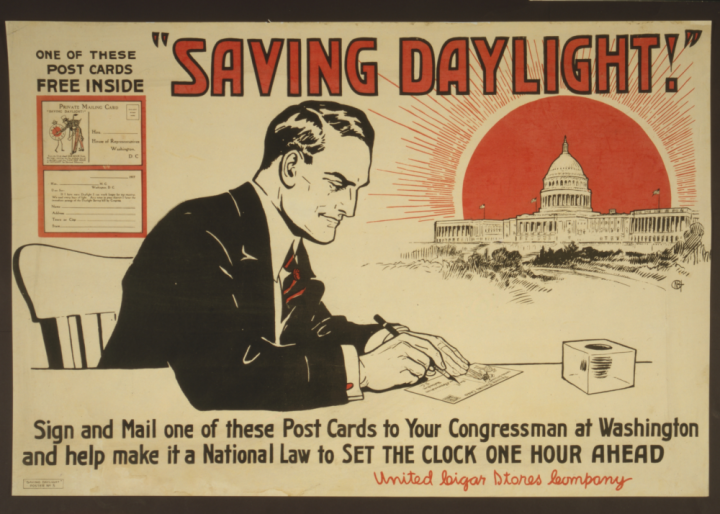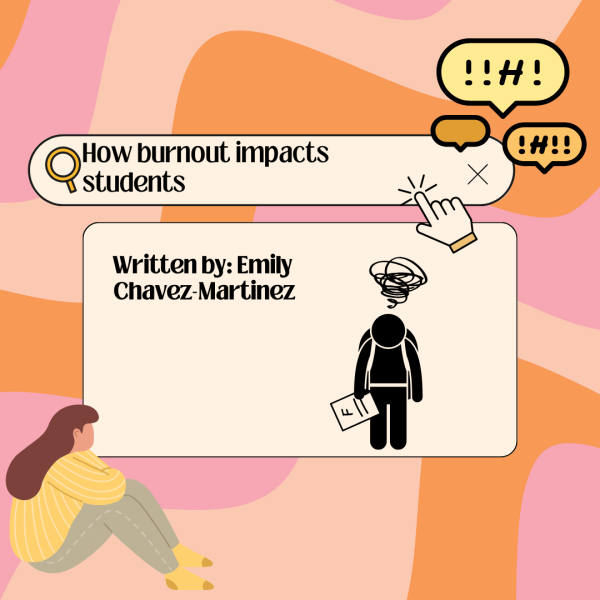Daylight Saving Time 2023 starts this Sunday, March 12th, 2023 at 2am EST!! Remember to fast forward all of your clocks 1 hour at this time!!

When Is Daylight Saving Time?
Daylight Saving Time begins on Sunday, March 12, 2023, at 2:00 A.M. At this time, we “spring forward” one hour! See details about the history of “saving daylight” and why we still observe DST today. Plus, let me know what you think! https://www.almanac.com/content/when-daylight-saving-time
What Is Daylight Saving Time?
Daylight Saving Time (DST) is the practice of moving the clocks forward one hour from Standard Time during the Summer months and changing them back again in the Fall. The general idea is that this allows us all to make better use of natural daylight: moving the clocks forward one hour in the Spring grants us more daylight during Summer evenings, while moving clocks back one hour in the Fall grants us more daylight during Winter mornings. However, DST has many detractors—and rightfully so! (Read more about this below.) https://www.almanac.com/content/when-daylight-saving-time
Daylight Saving Time 2023: When Does the Time Change?
Daylight Saving Time always begins on the second Sunday in March and ends on the first Sunday in November. To remember which way to set their clocks, folks often use the expression, “spring forward, fall back.” (Note that these dates are for locations in the United States and Canada only; other countries may follow different dates!) https://www.almanac.com/content/when-daylight-saving-time
- Daylight Saving Time begins on Sunday, March 12, 2023 at 2:00 A.M. On Saturday night, clocks are set forward one hour (i.e., losing one hour) to “spring forward.” https://www.almanac.com/content/when-daylight-saving-time
- Daylight Saving Time ends on Sunday, November 5, 2023, at 2:00 A.M. On Saturday night, clocks are set back one hour (i.e., gaining one hour) to “fall back.” https://www.almanac.com/content/when-daylight-saving-time
Note: Since the time changes at 2:00 A.M., we generally change our clocks before bed on Saturday. https://www.almanac.com/content/when-daylight-saving-time
Daylight Saving Time Dates:
| Year | Daylight Saving Time Begins | Daylight Saving Time Ends |
|---|---|---|
| 2023 | Sunday, March 12 at 2:00 A.M. | Sunday, November 5 at 2:00 A.M. |
| 2024 | Sunday, March 10 at 2:00 A.M. | Sunday, November 3 at 2:00 A.M. |
| 2025 | Sunday, March 9 at 2:00 A.M. | Sunday, November 2 at 2:00 A.M. |
| 2026 | Sunday, March 8 at 2:00 A.M. | Sunday, November 1 at 2:00 A.M. |
Is it Daylight “Saving” or “Savings” Time?
The correct term is “Daylight Saving Time“ and not “Daylight Savings Time” (with an extra “s”), though many of us are guilty of saying it the wrong way. The technical explanation is that the word “saving” is singular because it acts as part of an adjective rather than a verb. https://www.almanac.com/content/when-daylight-saving-time
The History of Daylight Saving Time:
Why Did Daylight Saving Time Start? https://www.almanac.com/content/when-daylight-saving-time
Should we blame Ben?
Benjamin Franklin’s “An Economical Project,” written in 1784, is the earliest known proposal to “save” daylight. It was whimsical in tone, advocating laws to compel citizens to rise at the crack of dawn to save the expense of candlelight:
“Every morning, as soon as the Sun rises, let all the bells in every church be set ringing: and if that is not sufficient, let cannon be fired in every street to wake the sluggards effectually… . Oblige a man to rise at four in the morning, and it is probable that he will go willingly to bed at eight in the evening.”
DST’s True Founder? https://www.almanac.com/content/when-daylight-saving-time
The first true proponent of Daylight Saving Time was an Englishman named William Willet. A London builder, he conceived the idea while riding his horse early one morning in 1907. He noticed that the shutters of houses were tightly closed even though the Sun had risen. In “The Waste of Daylight,” the manifesto of his personal light-saving campaign, Willet wrote, “Everyone appreciates the long, light evenings. Everyone laments their shrinkage as the days grow shorter; and nearly everyone has given utterance to a regret that the nearly clear, bright light of an early morning during Spring and Summer months is so seldom seen or used… . That so many as 210 hours of daylight are, to all intents and purposes, wasted every year is a defect in our civilization. Let England recognize and remedy it.”
Willet spent a small fortune lobbying businessmen, members of Parliament, and the U.S. Congress to put clocks ahead 20 minutes on each of the four Sundays in April, and reverse the process on consecutive Sundays in September. But his proposal was met mostly with ridicule. One community opposed it on moral grounds, calling the practice the sin of “lying” about true time.
How World War I Led to Adoption of DST: https://www.almanac.com/content/when-daylight-saving-time
Attitudes changed after World War I broke out. Both the government and the citizenry recognized the need to conserve coal used for heating homes. The Germans were the first to officially adopt the light-extending system in 1915, as a fuel-saving measure during World War I. This led to the introduction in 1916 of British Summer Time: From May 21st to October 1st, clocks in Britain were put an hour ahead.
The United States followed in 1918, when Congress passed the Standard Time Act, which established the time zones. However, this was amidst great public opposition. A U.S. government Congressional Committee was formed to investigate the benefits of Daylight Saving Time. Many Americans viewed the practice as an absurd attempt to make late sleepers get up early. Others thought that it was unnatural to follow “clock time” instead of “Sun time.” A columnist in the Saturday Evening Post offered this alternative: “Why not ‘save summer’ by having June begin at the end of February?”

But with public opinion in its favor, Congress officially declared that all clocks would be moved ahead one hour at 2:00 A.M. on March 31, 1918. (Canada adopted a similar policy later the same year.) Americans were encouraged to turn off their lights and go to bed earlier than they normally did—at around 8:00 P.M.
So, all in all, this is what Daylight Saving Time is all about and this is when it begins in the United States.
Your donation will support the student journalists of Dakota High School. Your contribution will allow us to purchase equipment and cover our annual website hosting costs.

Zachary Veal is a senior at Dakota High School. He is interested in music while playing percussion in his 3rd hour Concert Band class right here at Dakota,...











